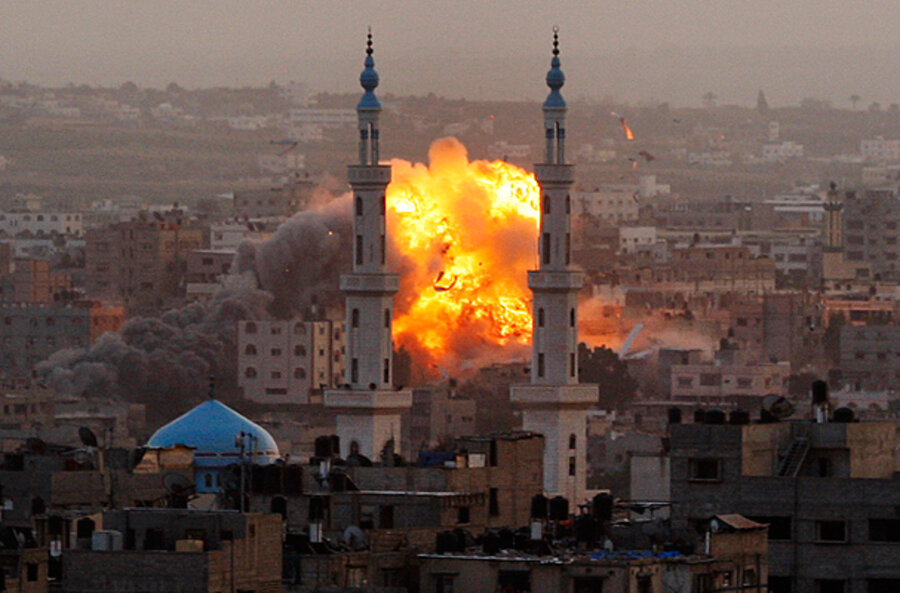As rockets fly, the Gaza image and propaganda war grinds on
Loading...
The blossoming Gaza war is even more than most wars about image and propaganda. Israel wants to set an image of implacable resolve to confront and destroy Hamas "terror." Hamas wants to set an image of implacable resolve to confront Israeli "terror" and "occupation." Both are trying to sway the political discourse inside the other's territory with this image-making.
Both their acts of violence and their propaganda, mostly online, are the tools with which they try to do that.
Every day since Wednesday, the ante has been upped. Israel assassinates Al Qassam Brigade (Hamas's military wing) chief Ahmed Jabari to send a message that rocket fire from Gaza must stop. The response? A barrage of missile fire from Gaza in the past four days, 737 rockets and mortars in all, more than the 723 fired over the course of the first 10 months of the year. The message from Hamas: You attack us, we respond even harder.
Israel intensifies its air campaign over Gaza. Hamas's response? Launching long-range rockets from its arsenal that it had withheld from use until now, firing at both Tel Aviv and Jerusalem. Tel Aviv, Israel's largest city and commercial hub, was threatened with aerial assault for the first time since 1991, when Saddam Hussein launched scud missiles toward the town. For Jerusalem, it was a stunning development: the first air raid sirens to sound there in history. The message from Hamas: We are developing a deterrent that we're willing to use on population centers.
The Israeli response to that? Calling up reservists and laying the ground work for an invasion of Gaza. While the decision has not been taken to go in, the posturing in that direction has put the situation on a knife's edge, since a ground assault would likely be a bloodier replay of the three-week Israeli invasion of Gaza in 2008 that ended with 1,200 Palestinians and 13 Israelis dead, and massive destruction to Gaza's infrastructure.
Israel insists its targeting is precise and focused on militants. Hamas makes no such claim, and, in fact, can't; the rockets fired from Gaza are the very definition of indiscriminate, hugely imprecise and more likely to kill civilians than anyone else. Hamas counters that far more of its civilians die at Israeli hands than vice versa, and its rockets the only tools at their disposal.
Israel has taken a hyper-aggressive approach to the war itself and its online image. With the decision to target civilian facilities of the Hamas government in Gaza today (the four-story office of Hamas Prime Minister Ismail Haniyeh in Gaza City was leveled, for instance), it appears to be sending the message to all Hamas officials that they're vulnerable to assassination. Fear, in many Israeli leaders' thinking, is the best weapon to force Hamas to give up its sporadic armed campaign against the Jewish state.
That may prove wise, or deeply unwise. Hamas in its own propaganda insists that it won't be deterred from resistance by the blood of "martyrs." And the historically disproportionate death toll when Gaza fights Israel (which has been maintained so far this time, with 3 Israelis killed against 40 Palestinians since Wednesday) tends to feed hatred against the Jewish state and a desire for revenge inside Gaza. That is, more willing recruits to fight.
But at least one can grasp the Israeli point of view, the frustration that leads to hope that intense bombing will create peace. Harder to understand is the Israeli online media strategy, which seems designed to preach exclusively to the choir with hyper-macho bluster.
The country has been rolling out gun-camera video of many of its aerial attacks inside Gaza, apparently to make the case that it uses precision targeting. The first such video issued was of the Wednesday assassination of Hamas commander Mr. Jabari as his car drove through one of Gaza City's narrow streets, the single event that led to the current state of war.
But will this help it to convince international folks without strong allegiances, or who may lean a little in a pro-Palestinian direction, to see things Israel's way? After the killing of Jabari, the IDF released a poster of him with the word "Eliminated" in big, white letters. When sharing a video of an attack on a Hamas commander's home in Gaza today that appeared to be hosting a weapons cache, judging by secondary explosions, an IDF spokesman included the twitter hashtag #stoptherockets. (There are other air strikes on Gaza in which no secondary explosions are apparent).
He obviously mean the rocket fire from Gaza, which has surged since Wednesday. But Israel's fire into Gaza has been far more lethal than vice versa. In another tweet on Thursday, the official IDF spokesperson's account shared a video of a rocket being fired from a residential area inside Gaza with the comment, "Would you raise your child in such a neighborhood?"
I'm quite certain that most Gaza parents are not at all happy about that, but it's not as if they have much choice. The majority of Gaza's 1.5 million residents today are Palestinian refugees who were pushed into the strip upon Israel's creation in 1948 and their descendants. Gaza is not allowed to have an airport or a seaport, and only a trickle of people are allowed to leave through either Egyptian or Israeli territory each year. Moving is quite simply not an option.
More interesting still was the threat issued on Wednesday: "We recommend that no Hamas operatives, whether low level or senior leaders, show their faces above ground in the days ahead." Hamas members are well aware they're targets. The point of the twitter conversation is to speak to a broader audience.
After the three week Operation Cast Lead in December 2008 and January 2009, Israel's international reputation took a hit because of the large number of Palestinian civilian casualties. Its sprawling media operation created since in part reflects frustration that the country is being unfairly maligned, and a belief that better military communication can fix that. Writing for Foreign Policy, Michael Koplow thinks they're going about it the wrong way:
"But the IDF's barrage of tweets indicates that it has not learned some important lessons from its last major incursion into Gaza. Operation Cast Lead, carried out in December 2008 and January 2009, was a tactical military victory that came at a costly price. The large numbers of Palestinian civilian casualties and images of destruction led to a renewed and vigorous effort to isolate Israel in the international community. The highest-profile example was the United Nations' Goldstone Report, conducted by South African judge Richard Goldstone, which damaged Israel immeasurably. The report was such a disaster for Israel that in 2009 Prime Minister Benjamin Netanyahu called it one of the three biggest threats Israel was facing, alongside a nuclear Iran and Palestinian rockets. The aftermath of Cast Lead also brought a renewed fervor to the Boycott Divestment Sanctions movement, which seeks to isolate and delegitimize Israel, and generally placed a harsher spotlight on Israeli efforts to deal with Hamas. In all, Israel beat Hamas on the battlefield but lost the war of public opinion, which in some ways was the more important one.
... The IDF is doing two things through its Twitter campaign that are replicating the same public relations mistakes it made the last time around. The first is a strategy of playing to its own base... Second, and more saliently, the reason Israel suffered so badly in the court of public opinion following Cast Lead is because there was a perception that Israel was callous about the loss of Palestinian life that occurred during that operation."
Indeed, the Atlantic's Jeffrey Goldberg refers to the IDF's war via Twitter as the "Hamasization" of Israel's public relations.
Hamas's propaganda is, if anything, even more aggressive and ham-handed, hence Goldberg's comment. The @alqassambrigade Twitter account is generally accepted as an English language outlet for Hamas's military wing (though there is some room for doubt) and has not only issued its share of chest-thumping and threats, but frequently inaccurate information. On Friday, the account falsely claimed that an Israeli jet had been shot down over Gaza.
More usually are simply absurd claims like this one from yesterday, saying the war is "going well in achieving historic goals, Liberation of occupied Palestine started ... we are coming IDF." Hamas does not have the ability to take any of the fight to the IDF, let alone defeat Israel.
In a nutshell, the propaganda campaigns are talking past each other, flying over the heads of anyone who could be reached by either side's message, and firing up their own already fired-up base.
That's a recipe for more war, not less.








